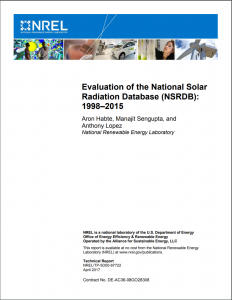Full Title: Evaluation of the National Solar Radiation Database (NSRDB): 1998–2015
Author(s): Aron Habte, Manajit Sengupta, and Anthony Lopez
Publisher(s): National Renewable Energy Laboratory
Publication Date: April 1, 2017
Full Text: Download Resource
Description (excerpt):
Achieving higher penetrations of solar energy conversion on the national electricity grid and reducing system integration costs requires accurate knowledge of the available solar radiation resource. Specifically, understanding the impacts of clouds and other meteorological constituents on the solar resource and quantifying intra-/inter-hour, seasonal, and interannual variability are essential for accurately designing utility-scale solar energy projects. Recognizing the importance of this need by industry and other stakeholders, the U.S. Department of Energy has funded the multiyear development of the National Solar Radiation Database (NSRDB) by the National Renewable Energy Laboratory (NREL). First released in 1992, the original NSRDB (1961– 1990) contained data for 239 locations for the period from 1961–1990. To meet the increased need for more current data from as many locations as possible, the NSRDB has been updated three times, resulting in the most recent NSRDB (1998–2015).
Solar resource information can be obtained from ground-based measurement stations and/or from modeled data sets. The availability of solar irradiance measurements is scarce, both temporally and spatially, because it is expensive to maintain a high-density solar radiation measurement network that collects good quality data for long periods of time. On the other hand, high temporal and spatial resolution gridded satellite-based observations of the atmosphere and reflected radiation data can be used to estimate surface radiation for long periods of time and is extremely useful for solar energy development. Because of the advantages of satellite-based solar resource assessment, NREL developed the physics-based Physical Solar Model (PSM). The PSM produced gridded solar irradiance—global horizontal irradiance (GHI), direct normal irradiance (DNI), and diffuse horizontal irradiance—for the NSRDB at a 4-km by 4-km spatial resolution and half-hourly temporal resolution covering the 18 years from 1998–2015. The NSRDB also contains additional ancillary meteorological data sets, such as temperature, relative humidity, surface pressure, dew point, and wind speed. Details of the model and resulting data are available at https://nsrdb.nrel.gov. Additional details about the PSM are also described in Xie, Sengupta, and Dudhia (2016) and Sengupta et al. (2015c).
A validation of the performance of the PSM-based data set in the NSRDB was conducted to quantify the accuracy of the magnitude and the spatial and temporal variability of the solar radiation data. Comparisons of the PSM estimates with selected ground-measured data were conducted under both clear- and cloudy-sky conditions and covered the period from 1998–2015 for seven Surface Radiation Budget Network stations as well as NREL’s Solar Radiation Research Laboratory and the Atmospheric Radiation Measurement program’s Southern Great Plains ground station. These locations provide a variety of geographical locations and climates.
The evaluation was conducted for hourly values, daily totals, monthly mean daily totals, and annual mean monthly mean daily totals. The modeled data were challenged because the satellite pixels cover a large area for which a snapshot is used to represent a time span, whereas the ground-based measurements represent a relatively small area above the measurement station at a higher temporal frequency (usually every minute).
The temporal and spatial evaluation was performed by comparing the NSRDB data to concurrent ground-based measurements. The results described in this paper show that the hourly-averaged satellite-derived data have a mean bias error of approximately +5% for GHI and less than +10% vi This report is available at no cost from the National Renewable Energy Laboratory (NREL) at www.nrel.gov/publications. for DNI; however, the scatter (root mean square error [RMSE]) difference is higher for the hourly averages: the GHI of the satellite demonstrates up to 20% RMSE when compared to the ground-based GHI measurements and up to 40% RMSE when compared to the ground-based DNI measurements. The interannual variability was investigated using a coefficient of variation, and the results demonstrate that the NSRDB and ground-measured data are comparable. This provides confidence that the NSRDB data set represents the variability in surface measurements (“ground truth”) throughout time. Both data sets demonstrated 5% variability on average. The annual solar radiation anomalies to the long-term mean were also investigated; 2015 was found to be the cloudiest year for the central and southern locations, with an approximate 10% reduction in GHI compared to the previous 18 years.
